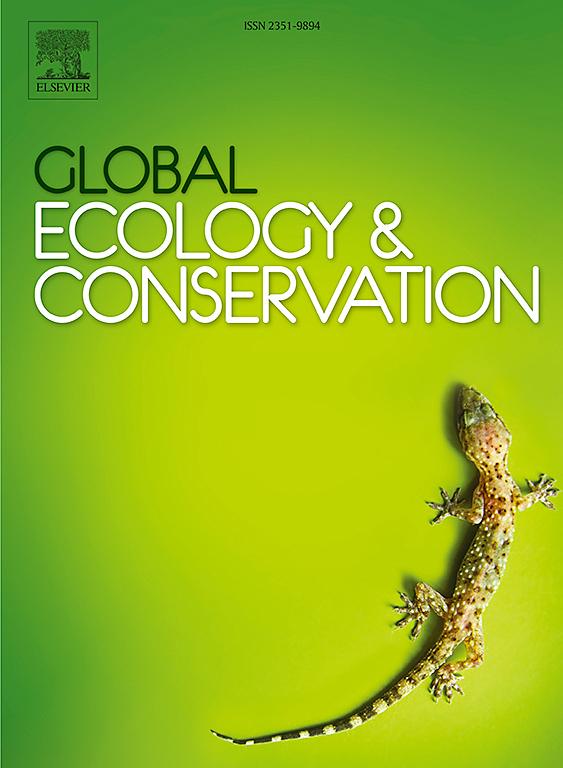气候和土地利用变化对中国胡杨林(Equus hemionus hemionus)栖息地的协同效应
IF 3.4
2区 环境科学与生态学
Q1 BIODIVERSITY CONSERVATION
引用次数: 0
摘要
气候和土地利用的变化是导致全球许多物种栖息地范围缩小的主要原因,尤其是广布的大型有蹄类动物。例如,栖息在亚洲沙漠地区的旗舰物种呼兰(),由于其对栖息地的广泛需求,表现出对栖息地丧失和破碎化的高度脆弱性。我们模拟了过去(1980-2000 年)、当前(2001-2022 年)和未来(2050 年和 2070 年)等 20 种气候和土地利用变化情景下中国适合胡杨的栖息地。对于每种情景,我们都确定了适宜的栖息地面积,并评估了保护区的有效性。我们的研究结果表明,胡杨栖息地面积从过去的 133,006 km 减少到目前的 60,141 km。未来情景表明,潜在的胡杨栖息地将进一步减少,而气候变化带来的负面影响要大于土地利用变化。预计在未来情景中,新疆北部仍将是胡杨的主要原地和异地栖息地。虽然现有保护区内的适宜栖息地面积小于保护区外,但保护区外的栖息地丧失率和破碎化率超过保护区内。这些发现强调了保护区有效管理战略的重要性,它是库兰持续保护工作的关键目标。我们的模型表明,未来适合呼兰的栖息地将位于中国和蒙古的国际边界沿线,毗邻呼兰栖息的蒙古保护区。加强这些栖息地之间的连通性将大大有助于改善呼兰种群的气候和基因恢复能力。本文章由计算机程序翻译,如有差异,请以英文原文为准。
Synergistic effects of climate and land use change on khulan (Equus hemionus hemionus) habitat in China
Climate and land use change are the primary drivers causing the reduction of habitat range for many species worldwide, especially wide-ranging and large-bodied ungulates. For instance, khulan (), a flagship species inhabiting desert regions of Asia, exhibits heightened vulnerability to habitat loss and fragmentation due to their extensive habitat requirements. We simulated suitable khulan habitats in China across 20 scenarios, including the past (1980–2000), current (2001–2022), and future (2050 s and 2070 s) climate and land use change scenarios. For each scenario, we identified the suitable habitat area and evaluated the effectiveness of protected areas (PAs). Our findings revealed a decline in khulan habitat area from 133,006 km in the past to 60,141 km at present. Future scenarios indicate further reductions in potential khulan habitat, with more negative impacts resulting from climate change than land use change. Northern Xinjiang is expected to persist as a primary area of both in-situ and ex-situ refugia for khulan in future scenarios. Although suitable habitat within existing PAs is smaller than that outside, the rates of habitat loss and fragmentation outside the PAs surpass those inside PAs. These findings emphasize the importance of effective management strategies for PAs as crucial goals for ongoing conservation efforts for the khulan. Our models suggest that future suitable habitat for khulan will be situated along the international border between China and Mongolia, adjacent to protected areas in Mongolia utilized by khulan. Enhancing connectivity between these habitats could significantly contribute to improving both the climate and genetic resilience of khulan populations.
求助全文
通过发布文献求助,成功后即可免费获取论文全文。
去求助
来源期刊

Global Ecology and Conservation
Agricultural and Biological Sciences-Ecology, Evolution, Behavior and Systematics
CiteScore
8.10
自引率
5.00%
发文量
346
审稿时长
83 days
期刊介绍:
Global Ecology and Conservation is a peer-reviewed, open-access journal covering all sub-disciplines of ecological and conservation science: from theory to practice, from molecules to ecosystems, from regional to global. The fields covered include: organismal, population, community, and ecosystem ecology; physiological, evolutionary, and behavioral ecology; and conservation science.
 求助内容:
求助内容: 应助结果提醒方式:
应助结果提醒方式:


